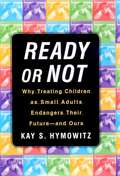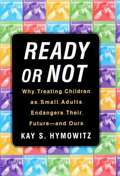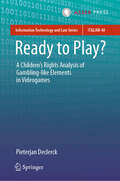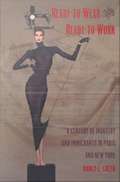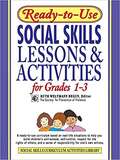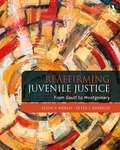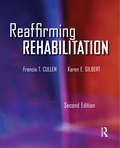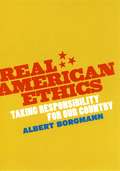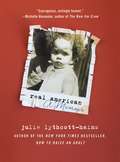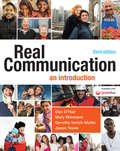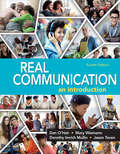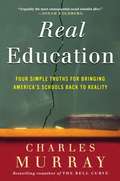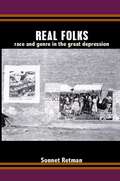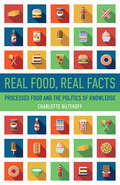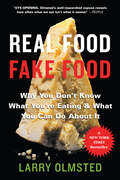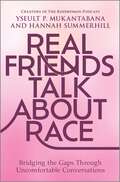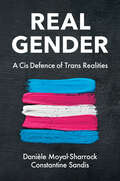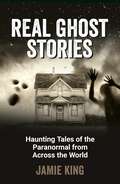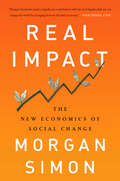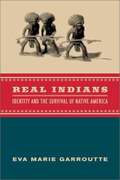- Table View
- List View
Ready or Not
by Kay S. Hymowitz"Children today grow up so fast!" How often we hear those words, uttered both in frustrated good humor and in dumbfounded astonishment. Every day the American people hear about kids doing things, both good and bad, that were once thought to be well beyond their scope: flying airplanes, running companies, committing mass murder. Creatures of the information age, today's children sometimes seem to know more than their parents. They surf the Internet rather than read books, they watch South Park instead of The Cosby Show, they wear form-fitting capri pants and tank tops instead of sundresses; in short, they are sophisticated beyond their years. These facts lead us to wonder: Is childhood becoming extinct? In Ready or Not, Kay S. Hymowitz offers a startling new interpretation of what makes our children tick and where the moral anomie of today's children comes from. She reveals how our ideas about childrearing itself have been transformed, perniciously, in reponse to the theories of various "experts" -- educators, psychologists, lawyers, media executives -- who have encouraged us to view children as small adults, autonomous actors who know what is best for themselves and who have no need for adult instruction or supervision. Today's children and teenagers have been encouraged by their parents and teachers to function as individuals to such an extent that they make practically every decision on their own -- what to wear, what to study, and even what values they will adhere to. The idea of childhood as a time of limited competence, in which adults prepare the young for maturity, has fallen into disrepute; independence has become not the reward of time, but rather something that our children have come to expect and demand at increasingly younger ages. One of the great ironies of turning our children into small adults is that American society has become less successful at producing truly mature men and women. When sophisticated children do grow up, they often find themselves unable to accept real adult responsibilities. Thus we see more people in their twenties and thirties living like children, unwilling to embark on careers or to start families. Until we recognize that children are different from grownups and need to be nurtured as such, Hymowitz argues, our society will be hollow at its core.
Ready or Not: Why Treating Children as Small Adults Endangers Their Future--and Ours
by Kay S. HymowitzIs the experience of childhood endangered? A leading voice on social issues offers startling evidence that it may be--unless we can stop treating our children as "small adults."
Ready to Play?: A Children’s Rights Analysis of Gambling-like Elements in Videogames (Information Technology and Law Series #40)
by Pieterjan DeclerckThis book approaches &‘gambling-like elements&’ such as lootboxes and social casino games from a children&’s rights perspective, focusing on the applicable existing legal framework and providing recommendations for future regulation. Analysed legal domains include gambling regulation, consumer protection and data protection regulation, as well as videogame industry self-regulation. An interdisciplinary approach serves as the foundation of the text; insights from non-legal disciplines such as psychology and media studies are integrated into the legal analysis. The book is aimed at readers with different levels of prior knowledge and experience regarding the topic, by providing both step-by-step explanations of videogame-related concepts and in-depth legal discussions within the various legal domains at different levels. It examines the recent evolution where children are increasingly engaging with a changing videogame environment in which the lines between videogames and gambling are blurred. By adopting a children&’s rights perspective, the book aims to add a fresh perspective to the legal debate related to the interacting worlds of videogames and gambling. As the book was written based on the doctoral research of the author, one especially relevant aspect is the inclusion of recommendations and wider suggestions directed at a variety of stakeholders in the field, ranging from policymakers at different levels, to industry representatives, legal scholars, parents and carers. Pieterjan Declerck is a Doctor in Law and is affiliated to the Department of Law and Technology at the Faculty of Law and Criminology at Ghent University in Belgium.
Ready, Steady, Go!: The Smashing Rise and Giddy Fall of Swinging London
by Shawn LevyIt’s the summer of 1966... The fundamental old ways: chastity, rationality, harmony, sobriety, even democracy: blasted to nothing or crumbling under siege. The city glows. It echoes. It pulses. It bleeds pastel and fuzzy, spicy, paisley and soft. This is how it's always going to be: smashing clothes, brilliant music, easy sex, eternal youth, the eyes of everybody, everyone's first thought, the top of the world, right here, right now: Swinging London.Shawn Levy has a genius for unearthing the secret history of popular culture. The Los Angeles Times called King of Comedy, his biography of Jerry Lewis, "a model of what a celebrity bio ought to be–smart, knowing, insightful, often funny, full of fascinating insiders' stories," and the Boston Globe declared that Rat Pack Confidential "evokes the time in question with the power of a novel, as well as James Ellroy's American Tabloid and better by far than Don DeLillo's Underworld."In Ready, Steady, Go! Levy captures the spirit of the sixties in all its exuberance. A portrait of London from roughly 1961 to 1969, it chronicles the explosion of creativity–in art, music and fashion–and the revolutions–sexual, social and political–that reshaped the world. Levy deftly blends the enthusiasm of a fan, the discerning eye of a social critic and a historian's objectivity as he re-creates the hectic pace and daring experimentation of the times–from the utter transformation of rock 'n' roll by the Beatles and the Rolling Stones to the new aesthetics introduced by fashion designers like Mary Quant, haircutters like Vidal Sassoon, photographers like David Bailey, actors like Michael Caine and Terence Stamp and filmmakers like Richard Lester and Nicolas Roeg to the wild clothing shops and cutting-edge clubs that made Carnaby Street and King's Road the hippest thoroughfares in the world. Spiced with the reminiscences of some of the leading icons of that period, their fans and followers, and featuring a photographic gallery of well-known faces and far-out fashions, Ready, Steady, Go! is an irresistible re-creation of a time and place that seemed almost impossibly fun.
Ready-To-Wear and Ready-To-Wear: A Century of Industry and Immigrants in Paris and New York
by Nancy L. GreenNancy L. Green offers a critical and lively look at New York's Seventh Avenue and the Parisian Sentier in this first comparative study of the two historical centers of the women's garment industry. Torn between mass production and "art," this industry is one of the few manufactauring sectors left in the service-centered cities of today. Ready-to-Wear and Ready-to-Work tells the story of urban growth, the politics of labor, and the relationships among the many immigrant groups who have come to work the sewing machines over the last century. Green focuses on issues of fashion and fabrication as they involve both the production and consumption of clothing. Traditionally, much of the urban garment industry has been organized around small workshops and flexible homework, and Green emphasizes the effect this labor organization had on the men and mostly women who have sewn the garments. Whether considering the immigrant Jews, Italians, Puerto Ricans, Dominicans, and Chinese in New York or the Chinese-Cambodians, Turks, Armenians, and Russian, Polish, and Tunisian Jews in Paris, she outlines similarities of social experience in the shops and the unions, while allowing the voices of the workers, in all their diversity to be heard. A provocative examination of gender and ethnicity, historical conflict and consensus, and notions of class and cultural difference, Ready-to-Wear and Ready-to-Work breaks new ground in the methodology of comparative history.
Ready-to-Use Social Skills Lessons and Activities For Grades PreK - K
by Social Skills Lessons and Activities For Grades PreK - KIn the early primary school years, children need to learn certain social skills to be successful in school and out. Some children have already mastered handling disappointment and working out differences with others, but many children struggle with the social skills that are expected of them. To help students of all skill levels, the author of the highly praised Ready-To-Use Violence Prevention Skills Lessons & Activities for Elementary Students presents this practical book that gives teachers and specialists a stimulating, systematic way to develop positive social behaviors in students through awareness, discussion, and rehearsing new behaviors. It offers over 50 detailed lesson plans and practice worksheets based on real-life situations. These age-appropriate lessons help children build self-esteem, self-control, respect for the rights of others, and a sense of responsibility for one's own actions. Printed in a spiral-bound 8 1/4" x 11" format, the pages can be easily photocopied for use by the whole class or for individuals as the need to work on a particular skill arises.
Reaffirming Juvenile Justice: From Gault to Montgomery
by Alida V. Merlo Peter J. BenekosThis book will expand students’ knowledge and understanding of the evolution of juvenile justice in the last 50 years. Designed to coincide with the 50th anniversary of the landmark case In re Gault, which the U.S. Supreme Court decided in 1967, the authors provide a brief history of juvenile justice, then frame the developments and transformations that have occurred in the intervening years. Topics covered include an overview of the dramatic changes to the field following the spike in youth violence in the 1990s, the "superpredator" myth, zero-tolerance policies, and sanctions for juvenile offenders—particularly the 2005 abolition of the death penalty and subsequent decision on life without parole. The book also covers child and youth victimization and trauma, and recent prevention and treatment initiatives. Designed for upper-level undergraduates, this text reflects on the evolving U.S. juvenile justice system while anticipating future challenges and trends. Reaffirming Juvenile Justice illustrates how ideology, media, and politics shape policy and how it can evolve.
Reaffirming Rehabilitation
by Francis T. Cullen Karen E. GilbertReaffirming Rehabilitation , 2nd Edition, brings fresh insights to one of the core works of criminal justice literature. This groundbreaking work analyzes the rehabilitative ideal within the American correctional system and discusses its relationship to and conflict with political ideologies. Many researchers and policymakers rejected the value of rehabilitation after Robert Martinson's proclamation that "nothing works." Cullen and Gilbert's book helped stem the tide of negativism that engulfed the U.S. correctional system in the years that followed the popularization of the "nothing works" doctrine. Now Cullen traces the social impact on U.S. corrections policy. This new edition is appropriate as a textbook in corrections courses and as recommended reading in related courses. It also serves as a resource for researchers and policymakers working in the field of corrections.
Reagan’s “Boys” and the Children of the Greatest Generation: U.S. World War II Memory, 1984 and Beyond (Routledge Advances in American History #13)
by Jonathan M. BullingerDuring the 1980s and 1990s, aging Baby Boomer parents constructed a particular type of memory as they attempted to laud their own parents’ wartime accomplishments with the label "The Greatest Generation." This book is the first to tell the entire story of this particular type of U.S. World War II memory begun by U.S. President Ronald Reagan in 1984, and promoted the same year by newscaster Tom Brokaw. The story continues in 1994, when it was given academic credence by historian Stephen E. Ambrose, a sensory realism and ideal American character by director Steven Spielberg and actor Tom Hanks, sloganized by Tom Brokaw in 1998, and later interpreted in light of 9/11 and new wars.
Real American Ethics: Taking Responsibility for Our Country
by Albert BorgmannAmerica is a wonderful and magnificent country that affords its citizens the broadest freedoms and the greatest prosperity in the world. But it also has its share of warts. It is embroiled in a war that many of its citizens consider unjust and even illegal. It continues to ravage the natural environment and ignore poverty both at home and abroad, and its culture is increasingly driven by materialism and consumerism. But America, for better or for worse, is still a nation that we have built. So why then, asks Albert Borgmann in this most timely and urgent work, are we failing to take responsibility for it? In Real American Ethics, Borgmann asks us to reevaluate our role in the making of American values. Taking his cue from Winston Churchill—who once observed that we shape our buildings, and then our buildings shape us—Borgmann considers the power of our most enduring institutions and the condition of our present moral makeup to propose inspired new ways in which we, as ordinary citizens, can act to improve our country. This, he shows, includes everything from where we choose to live and what we spend our money on to daunting tasks like the reshaping of our cities—habits and actions that can guide us to more accomplished and virtuous lives. Using prose that is easy and direct throughout, Borgmann’s position is grounded neither by conservative nor liberal ideology, but in his understanding that he is a devoted citizen among many. In an age in which the blame game is the only game in town, this patriotic book is an eloquent reminder of the political strength we all wield when we work together.
Real American Ethics: Taking Responsibility for Our Country
by Albert BorgmannAmerica is a wonderful and magnificent country that affords its citizens the broadest freedoms and the greatest prosperity in the world. But it also has its share of warts. It is embroiled in a war that many of its citizens consider unjust and even illegal. It continues to ravage the natural environment and ignore poverty both at home and abroad, and its culture is increasingly driven by materialism and consumerism. But America, for better or for worse, is still a nation that we have built. So why then, asks Albert Borgmann in this most timely and urgent work, are we failing to take responsibility for it? In Real American Ethics, Borgmann asks us to reevaluate our role in the making of American values. Taking his cue from Winston Churchill—who once observed that we shape our buildings, and then our buildings shape us—Borgmann considers the power of our most enduring institutions and the condition of our present moral makeup to propose inspired new ways in which we, as ordinary citizens, can act to improve our country. This, he shows, includes everything from where we choose to live and what we spend our money on to daunting tasks like the reshaping of our cities—habits and actions that can guide us to more accomplished and virtuous lives. Using prose that is easy and direct throughout, Borgmann’s position is grounded neither by conservative nor liberal ideology, but in his understanding that he is a devoted citizen among many. In an age in which the blame game is the only game in town, this patriotic book is an eloquent reminder of the political strength we all wield when we work together.
Real American: A Memoir
by Julie Lythcott-Haims“Courageous, achingly honest." —Michelle Alexander, New York Times bestselling author of The New Jim Crow: Mass Incarceration in the Age of Colorblindness“A compelling, incisive and thoughtful examination of race, origin and what it means to be called an American. Engaging, heartfelt and beautifully written, Lythcott-Haims explores the American spectrum of identity with refreshing courage and compassion.”—Bryan Stevenson, New York Times bestselling author of Just Mercy: A Story of Justice and RedemptionA fearless debut memoir in which beloved and bestselling How to Raise an Adult author Julie Lythcott-Haims pulls no punches in her recollections of growing up a biracial black woman in America.Bringing a poetic sensibility to her prose to stunning effect, Lythcott-Haims briskly and stirringly evokes her personal battle with the low self-esteem that American racism routinely inflicts on people of color. The only child of a marriage between an African-American father and a white British mother, she shows indelibly how so-called "micro" aggressions in addition to blunt force insults can puncture a person's inner life with a thousand sharp cuts. Real American expresses also, through Lythcott-Haims’s path to self-acceptance, the healing power of community in overcoming the hurtful isolation of being incessantly considered "the other." The author of the New York Times bestselling anti-helicopter parenting manifesto How to Raise an Adult, Lythcott-Haims has written a different sort of book this time out, but one that will nevertheless resonate with the legions of students, educators and parents to whom she is now well known, by whom she is beloved, and to whom she has always provided wise and necessary counsel about how to embrace and nurture their best selves. Real American is an affecting memoir, an unforgettable cri de coeur, and a clarion call to all of us to live more wisely, generously and fully.
Real Communication
by Dan O’hair Mary Wiemann Dorothy Imrich Mullin Jason TevenReal Communication uses stories from real people and the world around us as the foundation for the liveliest introduction to human communication available today. Professors and students alike have fallen in love with Real Communication's down-to-earth writing style, its current scholarship, and its wealth of learning and teaching tools. They also appreciate how Real Communication strives to weave together the discipline's different strands with CONNECT, a feature that shows students how to apply concepts across interpersonal, small group, and public speaking contexts.
Real Communication
by Dan O’hair Mary Wiemann Dorothy Imrich Mullin Jason TevenReal Communication uses the liveliest stories from real people and the world around us as the foundation for teaching the theory and skills of human communication available today. Professors and students alike have fallen in love with the authors'down-to-earth writing style and commitment to providing the most current scholarship that reflects the world we live in, from the challenges that arise with pervasive digital media to new ways for understanding listening goals. They also appreciate how Real Communication weaves together the discipline's different strands with "Connect," a feature that shows students how to apply concepts across interpersonal, small group, and public speaking contexts.
Real Education: Four Simple Truths for Bringing America's Schools Back to Reality
by Charles MurrayWith four simple truths as his framework, Charles Murray, the bestselling coauthor of The Bell Curve, sweeps away the hypocrisy, wishful thinking, and upside-down priorities that grip America's educational establishment.Ability varies. Children differ in their ability to learn academic material.Doing our best for every child requires, above all else, that we embrace that simplest of truths. America's educational system does its best to ignore it.Half of the children are below average.Many children cannot learn more than rudimentary reading and math. Real Education reviews what we know about the limits of what schools can do and the results of four decades of policies that require schools to divert huge resources to unattainable goals.Too many people are going to college. Almost everyone should get training beyond high school, but the number of students who want, need, or can profit from four years of residential education at the college level is a fraction of the number of young people who are struggling to get a degree. We have set up a standard known as the BA, stripped it of its traditional content, and made it an artificial job qualification. Then we stigmatize everyone who doesn't get one. For most of America's young people, today's college system is a punishing anachronism. America's future depends on how we educate the academically gifted. An elite already runs the country, whether we like it or not. Since everything we watch, hear, and read is produced by that elite, and since every business and government department is run by that elite, it is time to start thinking about the kind of education needed by the young people who will run the country. The task is not to give them more advanced technical training, but to give them an education that will make them into wiser adults; not to pamper them, but to hold their feet to the fire. The good news is that change is not only possible but already happening. Real Education describes the technological and economic trends that are creating options for parents who want the right education for their children, teachers who want to be free to teach again, and young people who want to find something they love doing and learn how to do it well. These are the people for whom Real Education was written. It is they, not the politicians or the educational establishment, who will bring American schools back to reality. Twenty-four years ago, Charles Murray's Losing Ground changed the way the nation thought about welfare. Real Education is about to do the same thing for America's schools.
Real Folks: Race and Genre in the Great Depression
by Sonnet RetmanDuring the Great Depression, people from across the political spectrum sought to ground American identity in the rural know-how of "the folk. " At the same time, certain writers, filmmakers, and intellectuals combined documentary and satire into a hybrid genre that revealed the folk as an anxious product of corporate capitalism, rather than an antidote to commercial culture. In Real Folks, Sonnet Retman analyzes the invention of the folk as figures of authenticity in the political culture of the 1930s, as well as the critiques that emerged in response. Diverse artists and intellectuals--including the novelists George Schuyler and Nathanael West, the filmmaker Preston Sturges, and the anthropologist Zora Neale Hurston--illuminated the fabrication and exploitation of folk authenticity in New Deal and commercial narratives. They skewered the racist populisms that prevented interracial working-class solidarity, prophesized the patriotic function of the folk for the nation-state in crisis, and made their readers and viewers feel self-conscious about the desire for authenticity. By illuminating the subversive satirical energy of the 1930s, Retman identifies a rich cultural tradition overshadowed until now by the scholarly focus on Depression-era social realism.
Real Food, Real Facts: Processed Food and the Politics of Knowledge
by Charlotte BiltekoffA free ebook version of this title is available through Luminos, University of California Press's Open Access publishing program. Visit www.luminosoa.org to learn more. In recent decades, many members of the public have come to see processed food as a problem that needs to be solved by eating "real" food and reforming the food system. But for many food industry professionals, the problem is not processed food or the food system itself, but misperceptions and irrational fears caused by the public's lack of scientific understanding. In her highly original book, Charlotte Biltekoff explores the role that science and scientific authority play in food industry responses to consumer concerns about what we eat and how it is made. As Biltekoff documents, industry efforts to correct public misperceptions through science-based education have consistently misunderstood the public's concerns, which she argues are an expression of politics. This has entrenched "food scientism" in public discourse and seeded a form of antipolitics, with broad consequences. Real Food, Real Facts offers lessons that extend well beyond food choice and will appeal to readers interested in how everyday people come to accept or reject scientific authority in matters of personal health and well-being.
Real Food/Fake Food: Why You Don't Know What You're Eating and What You Can Do About It
by Larry Olmsted“Olmsted makes you insanely hungry and steaming mad--a must-read for anyone who cares deeply about the safety of our food and the welfare of our planet.” —Steven Raichlen, author of the Barbecue! Bible series“The world is full of delicious, lovingly crafted foods that embody the terrain, weather, and culture of their origins. Unfortunately, it’s also full of brazen impostors. In this entertaining and important book, Olmsted helps us fall in love with the real stuff and steer clear of the fraudsters.” —Kirk Kardashian, author of Milk Money: Cash, Cows, and the Death of the American Dairy Farm You’ve seen the headlines: Parmesan cheese made from wood pulp. Lobster rolls containing no lobster at all. Extra-virgin olive oil that isn’t. So many fake foods are in our supermarkets, our restaurants, and our kitchen cabinets that it’s hard to know what we’re eating anymore. In Real Food / Fake Food, award-winning journalist Larry Olmsted convinces us why real food matters and empowers consumers to make smarter choices. Olmsted brings readers into the unregulated food industry, revealing the shocking deception that extends from high-end foods like olive oil, wine, and Kobe beef to everyday staples such as coffee, honey, juice, and cheese. It’s a massive bait and switch in which counterfeiting is rampant and in which the consumer ultimately pays the price. But Olmsted does more than show us what foods to avoid. A bona fide gourmand, he travels to the sources of the real stuff to help us recognize what to look for, eat, and savor: genuine Parmigiano-Reggiano from Italy, fresh-caught grouper from Florida, authentic port from Portugal. Real foods that are grown, raised, produced, and prepared with care by masters of their craft. Part cautionary tale, part culinary crusade, Real Food / Fake Food is addictively readable, mouthwateringly enjoyable, and utterly relevant.
Real Friends Talk About Race: Bridging the Gaps Through Uncomfortable Conversations
by Yseult P. Mukantabana Hannah SummerhillReal Friends Talk About Race is an essential guide for those who want to have stronger interracial relationships—whether it&’s with friends, colleagues, or loved ones. Having conversations about race is uncomfortable. But for progress between individuals (and our communities) to happen, we need to be able to speak openly and honestly. Podcast hosts of The Kinswomen Yseult and Hannah use their own friendship and experiences from different racial backgrounds to offer guidance on navigating these layered conversations. In Real Friends Talk About Race, the duo share their two perspectives on the ways in which culture, history, and white supremacy have prevented us from having the skills to build trust and healthy relationships across race. Yseult and Hannah approach these topics with love and candor—calling readers in (not out) to confront hard realities and their own internalized biases, while also sharing prescriptive advice, encouragement, and a sense of community.Real Friends Talk About Race is a must-read for anyone looking to listen, learn, and feel empowered to have meaningful conversations about race.
Real Gender: A Cis Defence of Trans Realities
by Constantine Sandis Danièle Moyal-SharrockSocieties around the world are struggling to think clearly about trans realities and understand trans identities. Real Gender is the first book to present a cis defence of what it means to be transgender. Moyal-Sharrock and Sandis delve into the various factors which make many trans people’s experience of their gender (or lack thereof) as natural and unquestionable as that of cis people. While recognising the undeniably social aspects of gender, they find that gender cannot be completely divorced from our biological underpinnings. Contrary to popular opinion, gender self-identification does not require the denial of either biology or sex. What is needed is a more liberal understanding of our gender concepts, which would prevent us from confusing diversity with pathology. Steeped in published and personal trans testimonials, Real Gender does not seek to provoke or attack, but to unequivocally defend trans realities. A powerful exploration of a divisive topic, this book will be of interest to a wide audience of readers.
Real Ghost Stories: Haunting Tales of the Paranormal from Across the World
by Jamie KingFilled with tales of ghosts and ghouls, poltergeists and other unexplained encounters, this bone-chilling compendium of paranormal phenomena is sure to haunt you long after you have turned the final page. But beware: after sampling these sinister histories, you might be too scared to close your eyes - no matter how much your body craves sleep.
Real Ghost Stories: Haunting Tales of the Paranormal from Across the World
by Jamie KingFilled with tales of ghosts and ghouls, poltergeists and other unexplained encounters, this bone-chilling compendium of paranormal phenomena is sure to haunt you long after you have turned the final page. But beware: after sampling these sinister histories, you might be too scared to close your eyes - no matter how much your body craves sleep.
Real Heat: Gender and Race in the Urban Fire Service
by Carol ChetkovichThirty years of legal and political efforts have opened the doors of this historically white male preserve, but men of color have yet to consolidate their gains, and women's progress has been even more tenuous. In this unique and compelling account of affirmative action at the "street level," Carol Chetkovich explores the ways in which this program has succeeded and failed.
Real Impact: The New Economics of Social Change
by Morgan SimonImpact investment--the support of social and environmental projects with a financial return--has become a hot topic on the global stage; poised to eclipse traditional aid by ten times in the next decade. But the field is at a tipping point: Will impact investment empower millions of people worldwide, or will it replicate the same mistakes that have plagued both aid and finance?Morgan Simon is an investment professional who works at the nexus of social finance and social justice. In Real Impact, she teaches us how to get it right, leveraging the world's resources to truly transform the economy. Over the past seventeen years, Simon has influenced over $150 billion from endowments, families, and foundations. In Real Impact, Simon shares her experience as both investor and activist to offer clear strategies for investors, community leaders, and entrepreneurs alike. Real Impact is essential reading for anyone seeking real change in the world.
Real Indians: Identity and the Survival of Native America
by Eva Marie GarroutteAn insightful and original analysis of the competing ways that Indian identity is defined, followed by a discussion of a new way of defining Indian-ness, which the author calls "indigenous theory."
